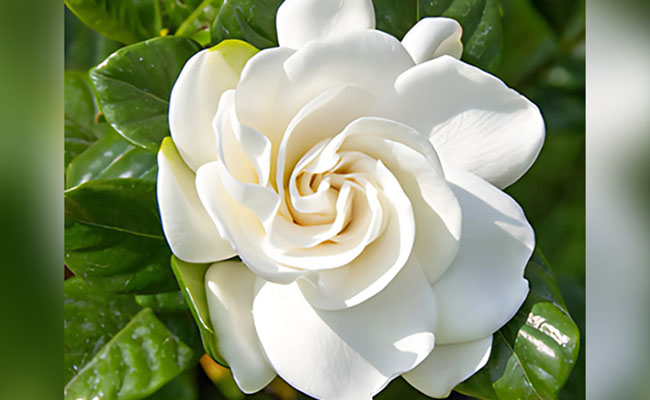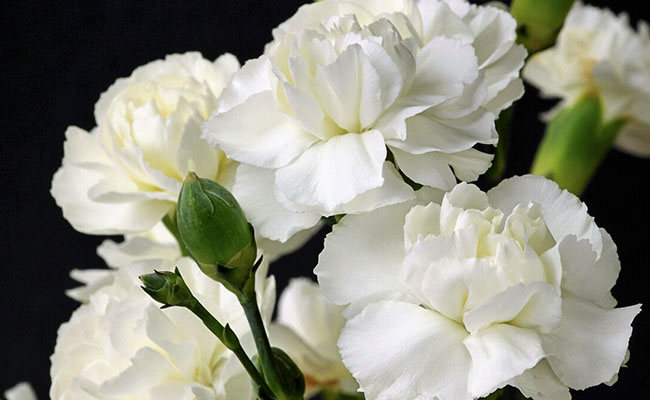Everything You Need to Know About White Flowers
White flowers have long held a special place in our hearts and traditions, captivating us with their understated elegance and universal appeal. From joyful celebrations to solemn ceremonies, these blooms transcend cultures and time periods, bringing beauty and meaning to countless occasions.

This blog is a comprehensive guide to the allure of white flowers, uncovering their symbolism, popular types, common uses, and the best ways to care for them. Whether you're planning a wedding, looking for a meaningful gift, or simply drawn to their pristine charm, this guide will take you on an enlightening journey through the world of white flowers.
The Significance of White Flowers
Wondering, "What do white flowers mean?" Let's answer that! White flowers embody qualities that resonate deeply with human emotions: purity, peace, and innocence. Their symbolism is woven into both modern and ancient practices, where they represent moments of new beginnings, remembrance, and hope. In essence, white flowers evoke feelings that words sometimes fail to express.
Common Occasions Featuring White Flowers
Depending on the types of white flowers, they find their way into a myriad of events. Here are some of the most common occasions where white flowers take center stage:
Weddings: White flowers are a classic choice for weddings, often seen in flower bouquets, centerpieces, and even decorative arrangements. Roses, lilies, or peonies are some of the most common white flower names you frequently hear about in marriage ceremonies, especially in the West.
Funerals and Memorial Services: White flowers are often chosen to represent peace and the hope of eternal rest. Lilies and chrysanthemums are frequent choices in sympathy arrangements as they convey sentiments of remembrance and the sanctity of the soul.
Religious and Spiritual Ceremonies: In various faiths, some white flower types are used as offerings or adornments, signifying devotion and spiritual purity.
Home Décor: White flowers bring an element of serenity and sophistication to living spaces, adding a touch of natural beauty without overwhelming other design elements.
Celebratory Events: White flowers are perfect for anniversaries, christenings, and graduations, representing hope, success, and new achievements.
The Symbolism of White Flowers
White flowers carry a range of meanings, but they are most commonly associated with purity, innocence, and peace. Their significance extends beyond simple beauty, encompassing deeper symbolic meanings that resonate across cultures. White flowers are often the first choice when a message of sincerity, humility, or respect needs to be conveyed.
Cultural Variations in Meaning
Different cultures imbue white flowers with distinct meanings. In Western traditions, they represent new beginnings and virtue, which is why they are so popular in weddings and baptisms. On the other hand, in many Asian cultures, white flowers, especially chrysanthemums, are associated with mourning and are frequently used at funerals. Understanding these cultural nuances helps in choosing the appropriate white flower for specific occasions.
Popular Types of White Flowers and Their Meanings
From delicate, small white flowers to grand, majestic varieties, these blooms come in many forms, each with its unique charm. Here are some of the most common and captivating types you can find in nature.
Lily
Description and Characteristics: The lily is admired for its large, trumpet-shaped blossoms and an alluring fragrance that can fill a room. With sturdy, elegant stems, lilies are available in various forms, such as Asiatic, Oriental, and Calla lilies.

Symbolism and Meanings: The white lily is synonymous with purity and renewal. In Christian iconography, it is often linked to the Virgin Mary, symbolising her purity and grace.
Common Uses
- Weddings: Lilies add a sophisticated touch to bridal bouquets and wedding décor.
- Funerals: They express sympathy and the wish for peace for the departed soul.
- Interior Design: Lilies are used to create a serene and elegant atmosphere in homes and offices.
White Rose
Description and Characteristics: White roses are distinguished by their velvety petals and subtle fragrance. They are classic and timeless, making them a favourite for many occasions and events.

Symbolism: Purity, loyalty, and innocence are what white roses stand for. They are also often seen as emblems of new beginnings.
Common Uses
- Bridal Arrangements: White roses are a staple in bridal bouquets and wedding arches.
- Sympathy Bouquets: They convey respect, love, and remembrance in times of loss.
- Anniversaries: They are ideal for celebrating years of loyalty and enduring love.
Daisy
Description and Characteristics: Daisies have a simple yet cheerful look, with bright white petals surrounding a vibrant yellow centre. Their charm lies in their unassuming beauty and irresistible appeal.

Symbolism: Innocence and purity are what come to mind when it comes to daisies. They are considered emblems of loyal love and new beginnings.
Common Uses
- Baby Showers: This white flower with a yellow center is very commonly spotted in baby showers to celebrate and welcome the arrival of a new baby.
- Spring Festivals: Their bright appearance brings freshness and joy to seasonal celebrations.
- Friendship Bouquets: Daisies are commonly given as tokens of appreciation and honest friendships.
Orchid
Description and Characteristics: Orchids are exotic flowers known for their unique shape and breathtaking beauty. They have a long-lasting bloom and come in a variety of colours, with white orchids being particularly elegant.

Symbolism: White orchids stand for beauty, strength, and delicate charm. They are often given to loved ones as symbols of admiration and respect.
Common Uses
- Weddings: White orchids make stunning arrangements that represent the strong and enduring bond of the couple.
- Gift Arrangements: Orchids are a sophisticated choice for birthdays, anniversaries, and thank-you gifts.
- Home Décor: Their striking appearance makes them ideal for modern interior settings.
Jasmine
Description and Characteristics: Jasmine flowers are small, star-shaped, and emit a sweet fragrance that is most pronounced at night. The white variety is especially prized for its calming scent and aesthetic.

Symbolism: Jasmine symbolises love, beauty, and sensuality. In some cultures, it is associated with purity and divine hope.
Common Uses
- Weddings: Jasmine is often woven into bridal garlands and bouquets.
- Perfumes and Essential Oils: Despite their small size, these tiny white flowers have a mesmerising scent and are widely used in the beauty industry.
- Tea: Jasmine-infused tea is known for its soothing properties.
Chrysanthemum
Description and Characteristics: Chrysanthemums, with their intricate, layered petals, offer a beautiful bloom that comes in various shapes and sizes. White chrysanthemums, in particular, have a soft, elegant appearance.

Symbolism: White chrysanthemums are symbols of loyalty, truth, and sincerity. In some cultures, they also represent mourning and loss.
Common Uses
- Funeral Arrangements: Commonly used in wreaths and sympathy bouquets to express grief and respect.
- Seasonal Displays: Their long-lasting nature makes them popular in autumnal arrangements.
- Gardens: Chrysanthemums add late-season beauty to flowerbeds.
Gardenia
Description and Characteristics: Gardenias are distinguished by their waxy, snow-white petals and alluring fragrance. They are delicate and require careful handling to maintain their pristine appearance.

Symbolism: Gardenias are often associated with love, trust, and refinement. They are also symbolic of secret love due to their elegant beauty.
Common Uses
- Weddings: Gardenias are a beautiful addition to bridal bouquets and wedding centrepieces.
- Corsages: Frequently used in formal events for their classic look and fragrance.
- Gift Bouquets: Ideal for conveying admiration and sincere affection.
Peony
Description and Characteristics: Peonies are large, full flowers that bloom in an array of layers. Their lush appearance makes them stand out in any arrangement.

Symbolism: White peonies are symbols of prosperity, good fortune, and a happy marriage. They are also associated with compassion and a pure heart.
Common Uses
- Weddings: Peonies are highly sought after for bridal bouquets and floral displays.
- Festive Events: Often used in celebrations to represent prosperity.
- Home Décor: A vase of peonies adds an instant touch of luxury to any space.
Calla Lily
Description and Characteristics: Calla lilies are one-of-a-kind with their sleek, funnel-shaped blooms. Their simplicity and refined appearance make them a popular choice for sophisticated arrangements.

Symbolism: White calla lilies are associated with elegance, beauty, and rebirth. They are often seen in both joyful and solemn events.
Common Uses
- Weddings: Often used in bridal bouquets for their classy shape.
- Sympathy Flowers: Symbolising peace and hope during times of grief.
- Anniversaries: They are the epitome of gracefulness, making them suitable for celebrating lasting love.
Carnation
Description and Characteristics: White carnations are known for their ruffled petals and subtle fragrance. They have a gentle, enduring beauty that makes them a versatile addition to various floral creations.

Symbolism: White carnations stand for pure and evergreen love, making them ideal for expressions of admiration and loyalty. They are also seen as symbols of good luck and innocence.
Common Uses
- Mother's Day: White carnations are a popular choice to show appreciation and unconditional love—two emotions that form the backbone of the bond between a mother and child.
- Sympathy Arrangements: They are also often used to convey love and respect for those who have passed, expressing remembrance and admiration.
- Celebratory Bouquets: They are used in arrangements for various milestones to signify good fortune and lasting affection.
How to Care for White Flowers
Keeping white flowers fresh and vibrant requires attention to detail. Here are some general tips and specific care instructions for popular white flowers:
- Trim Stems: Always cut the stems at an angle before placing them in water to improve water uptake.
- Change Water Regularly: Refresh the water every two days to prevent bacterial growth.
- Remove Leaves: Strip any leaves that fall below the waterline to avoid decay.
- Optimal Light: Place the flowers in a spot with indirect sunlight for the best results.
- Temperature: Maintain a cool environment to prolong their freshness.
Specific Care Tips for Popular White Flowers
Here is how you can optimally care for the white flowers mentioned in this blog.
- Lilies: Ensure that pollen is removed to avoid staining and prolong their beauty. Change water frequently and trim stems every few days.
- Roses: Recut stems regularly and use flower food to keep them looking fresh. Gently mist the petals to maintain moisture.
- Orchids: Mist them occasionally and water sparingly. Orchids thrive in bright, indirect light.
- Daisies: Keep daisies in clean water and check the stems regularly for any signs of wilting.
- Jasmine: Place in a warm spot with natural light and keep the soil or vase water slightly moist.
- Chrysanthemums: Remove wilted flowers promptly and ensure good airflow around the stems to prevent mildew.
- Gardenias: Gardenias are sensitive, so mist them lightly and keep them in a humid environment.
- Peonies: Recut the stems and change water every two days. Peonies benefit from cooler temperatures.
- Calla Lilies: Trim the stems at an angle and ensure they are placed in a shallow amount of water to prevent rotting.
- Carnations: Change water regularly and cut stems slightly above the previous cut to enhance water absorption.
Wrapping Up
The magic of white flowers is undeniable. Their ethereal beauty has the power to make you pause and admire them, even when seen by the roadside. We hope this blog has provided you with a deeper appreciation and understanding of these delicate blooms. Whether you're looking to send flowers online to a loved one or decorate your home, these white flowers are the way to go.















